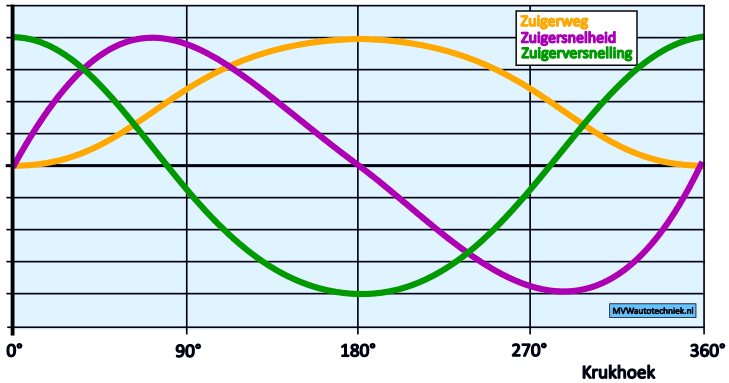Subjects:
- Preface
- Primary and secondary piston movements
- Piston speed
- Piston acceleration
- Complete overview of piston travel, speed and acceleration
Preface:
The up and down (translating) movement of the piston is converted into a rotating movement by the crank-connecting rod mechanism. The piston moves up and down in a straight line. This is called the primary piston movement. However, the connecting rod not only moves up and down, but also sideways. Due to the lateral movement of the connecting rod, the piston will travel a slightly greater distance. In addition to the increased distance, the piston has also reached its highest speed of movement at this point. This extra distance is called the secondary piston movement.
The picture shows the piston movement. The top blue piston shows where the TDC (Top Dead Center) is. The blue piston in the center right indicates the distance of the primary piston movement (ie where the connecting rod has not become oblique). The lower red-colored piston indicates the extra distance created by the rotation of the crankshaft and the oblique position of the connecting rod; this is the secondary piston movement.
When the crankshaft is rotated 90 degrees, the speed of movement of the piston is highest. The secondary piston movement provides a greater distance covered. By adding the distance of the secondary movement to that of the primary movement, the total distance traveled by the piston can be determined.
The ratio between the length of the crank journal and the length of the connecting rod determines the magnitude of the secondary movement. The secondary piston movement also has an effect on the piston speed and piston acceleration.
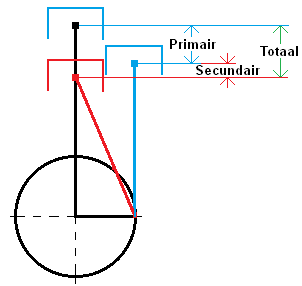
Primary and secondary piston movements:
The primary and secondary piston movement are shown in graphs in this section as the distance traveled. The sum of the primary and secondary piston movement is the total piston movement. The structure of the total piston path is explained below.
Primary piston movement:
The force in the direction TDC to TDC and the force from ODP to TDC together cause a vibration that occurs once per crankshaft revolution. That is why this force is also called the primary force. The primary force makes a primary movement.
- The primary piston movement is 0 at 0° crankshaft rotation and also 180 at 0°;
- If we look exclusively at the primary piston movement, with 90° crankshaft rotation the piston is halfway through the stroke (also halfway through the cylinder), namely at 90 mm.
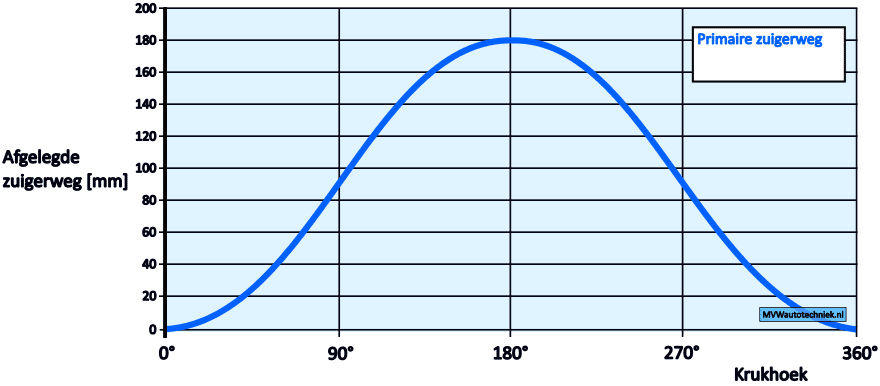
Secondary piston movement:
The lateral movement of the connecting rod provides the secondary piston movement. The greater the ratio between crank pin and connecting rod length, the greater the secondary force, and therefore the secondary movement.
- At TDC the secondary movement is 0;
- At 90° crankshaft rotation the secondary movement is maximum;
- We add the distance that the piston covers during the secondary movement to the primary movement. This is the actual path the piston has traveled.
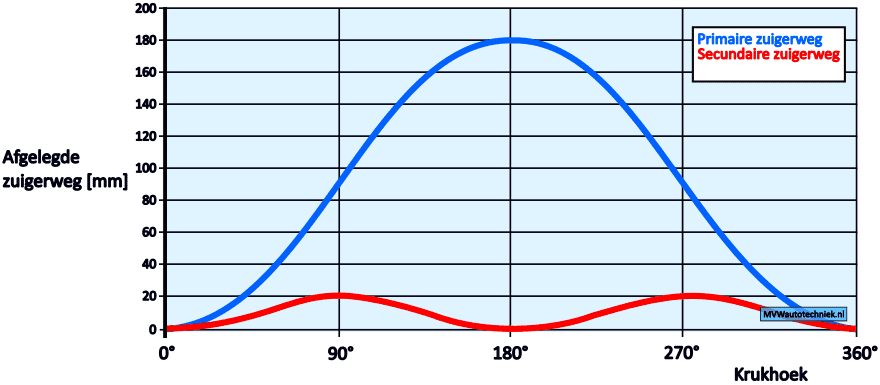
Actual piston movement:
The actual piston movement is formed by the sum of the primary and secondary piston movement. This can be read as “total” in the graph.
- The piston is already halfway through its stroke in the cylinder before the crankshaft has turned 90 degrees. In the graph we see that the piston has traveled 110 mm at 90 degrees. That's 61% of the total stroke;
- The length of the crank journal, and therefore the crank-connecting rod ratio (often referred to as lambda), determines the secondary, and therefore total piston travel.
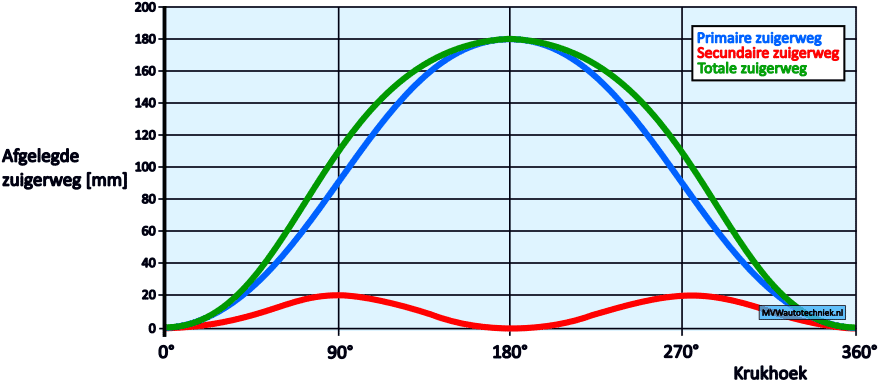
The secondary piston movement amplifies the engine vibrations. In an engine with four or fewer cylinders, where the secondary forces are relatively large, balance shafts applied to limit engine vibrations.
Piston Speed:
During the working process, the piston reverses its direction of movement at ODP and TDC. At ODP and TDC the piston speed is zero. This is because the piston changes direction at these points. As the piston moves from TDC to ODP, the piston speed increases. The primary piston speed reaches its maximum value around 90 degrees of crankshaft rotation. This is the result of the positive acceleration of the piston during the downward movement. However, as the connecting rod angle increases, secondary piston speed comes into play. The secondary piston speed is related to the tilt of the connecting rod and causes an additional contribution to the total piston speed. This secondary piston speed causes the total piston speed to reach its maximum value sooner than the primary piston speed alone would cause. This typically happens before the 90 degree crankshaft angle. In the graph below we see that the total piston speed is already maximum at approximately 75%.
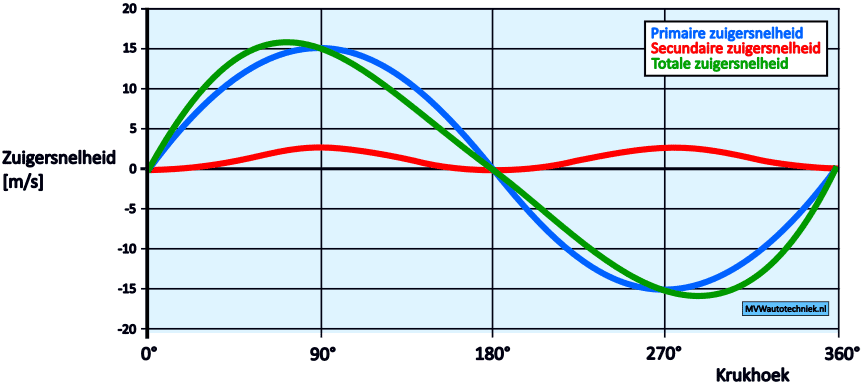
Piston acceleration:
The piston speed was discussed in the previous paragraph. The graph shows that the piston speed at TDC and ODP is 0, and the speed increases and decreases during downward and upward movement. With piston acceleration we look at the acceleration and deceleration of the piston in the cylinder.
When the crank angle is 0 degrees, the piston is at the top of its stroke, ready to begin its downward movement. Piston acceleration is maximum at this point. This is due to the abrupt change in the direction of movement of the piston, from stopping at the highest point to starting the downward movement. While moving towards TDC the acceleration decreases. The primary piston acceleration is 0 at 90 degrees of crankshaft rotation. In the previous paragraph we can see that the piston speed decreases again at 90 degrees. Between 90 and 180 crankshaft degrees the piston brakes until it reaches TDC. In the graph we see braking as negative acceleration.
The secondary piston acceleration is again created by the tilting of the connecting rod. In an engine with an off-axis connecting rod, the connecting rod is already at a small angle when the piston is at TDC. As a result of the secondary piston acceleration, the total piston acceleration increases in the first crankshaft degrees.
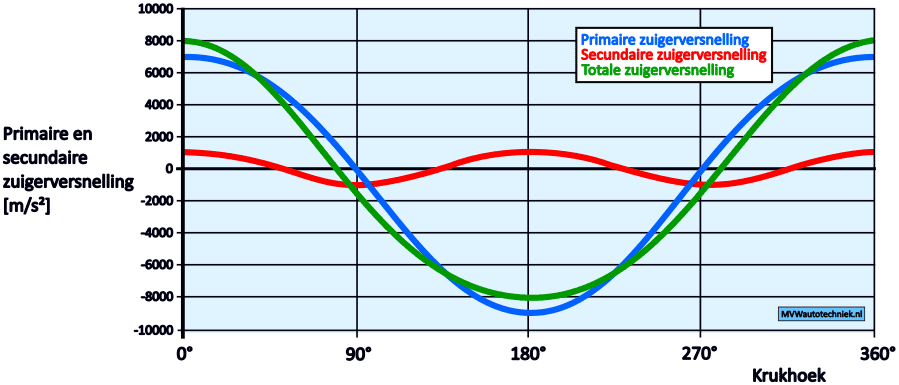
Total overview of piston travel, speed and acceleration:
The previous paragraphs discussed the primary, secondary and total movements and speeds for each graph. In this overview we see the totals in one graph.
- As the piston moves downwards, the piston weight increases (from 0 to 180°);
- The piston has reversed its direction of motion between the previous stroke and the current stroke. Due to the sudden change in direction of movement, the piston acceleration is maximum from 0 crankshaft degree;
- The piston speed increases gradually, reaching a maximum before the crankshaft has rotated 90°;
- At 180°, both piston speed and piston acceleration are 0;
- While moving up to TDC, the piston acceleration and speed graphs reverse.
